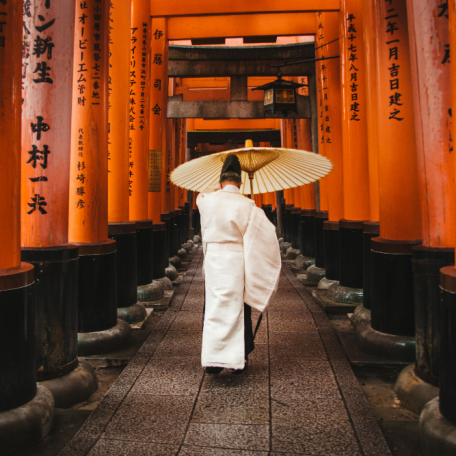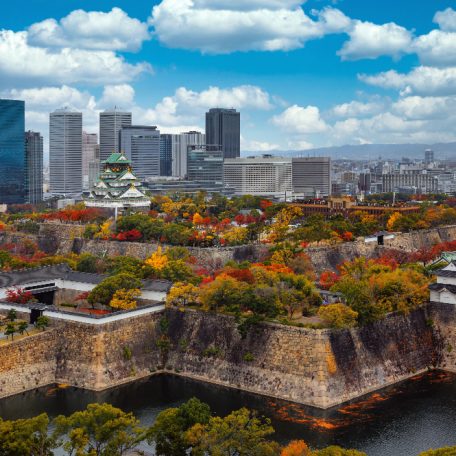The Best Kōyō (Autumn Leaves) in Aomori!
Sep 27, 2022
BY Megan Lizee

I wanted to title this with some sort of pun, like “best place to go see the forest in the fall? Ao-MORI of course!” then I realized the better pun is “Best place for fall fun? AKI-ta,” but I digress. Japan’s seasons bring cycles of limited-edition activities, for example, cherry-blossom viewing for spring, or festivals for the summer. However, fall in Japan is the time to experience one of my favourite things ever, fall colours, or in Japanese “紅葉”. Japan is gifted with beautiful mountains and coming from Eastern Canada where it is relatively flat, it is always my mission to find the best kōyō spots. Fortunately, Aomori, where I reside, has some of the best spots to get your autumn-aesthetic Instagram photos.
Today I want to specifically introduce the one place I have pretty much gone to every year for the past five years I have been here in Japan (unfortunately I didn’t go my first year). The Hakkoda Mountains in Aomori have some of the most beautiful kōyō I have ever seen. The mountain range is perfect for a day trip up the mountain, you can access it from roads that start in Towada, Shichinohe, Aomori City, or Hirosaki.

Photo by Megan Lizee
I always make the end goal of my driving to be Jogakurao Bridge, a vast arch bridge perched in the trees. Depending on which way you will travel, you will pass either the Hakkoda Ropeway or Sukayu Onsen. I love an excellent onsen, so I usually go there second. The ropeway is amazing, but your timing needs to be precise, as the leaves at the very peak of the mountain will most likely have fallen already as to when the leaves are gorgeous around the bridge/onsen area. What I recommend is you go on the ropeway in the winter/early spring to see the Snow Monsters of Hakkoda, which are similar to the ones in Yamagata.

Photo by Megan Lizee

(The bridge is towards the middle where the red marker is pointing to. That is me haha!) – Photo by Megan Lizee
Back to Sukayu Onsen, an over 300-year-old onsen and ryokan. This is personally my favourite onsen in Aomori because of the mix of beautiful scenery, food, architecture, and of course the water itself. When I first came across the building, it had exposed brown beams that you usually see in European architecture, which I thought was interesting for a Japanese Ryokan. When you go inside you can either access the expansive omiyage shop and restaurant or take off your shoes to go to the onsen.
My usual route is to pay the admission fee of about 1000 yen to take a bath after trekking around the chilly mountains, furthermore, there are both single-sex and mixed baths. The mixed bath is the biggest one, but I was a bit nervous because I have only gone to single-sex onsens. . My friend reassured me there was a wall at the women’s entrance that covers you as you walk in. In addition, I was also happy to learn that the water is pure white, so you don’t need to be self-conscious. Lastly, I have skin issues, and the high levels of sulfur in the water literally subsided my symptoms for a week or two. I was shocked, and promptly bought the Sukayu-onsen-water soap that was in the omiyage shop. If you are worried about the sulfur smell afterward, go to the single-sex baths to access the shower areas.

(A photo of the front entrance of the onsen from afar.) – Photo by Megan Lizee
Time to talk about food! The food found at the Sukayu Onsen restaurant was delicious! The menu was mainly soba and udon, but the toppings on the noodles are all local vegetables in the mountains. Some of the tempura were some I’ve never had before! They also have fresh spring water pouring out of a fountain in the corner of the restaurant which was perfect to pair with the mountain vegetable tempura and soba.
So to close off my recommendations, I recommend you go up the mountain earlier than the Koyo would be at the bottom of the mountain, the first leaves you see change outside your house, head up right away! If you like historical monuments/landmarks go to the Infantry 5th Regiment 2nd Battalion Disaster Monument (where the Hakkoda Death March occurred) about 10 minutes past the ropeway.
Lastly, Oirase Gorge is just at the bottom of the mountain, and it always ranks as “One of the most picturesque places in Japan.” The hike is beautiful and I find it perfect because it is not too demanding, so you can really take in the views. The trees surround you, and if you follow the river, you see waterfalls occasionally. Some say it takes about three to four hours to walk the entire gorge, but I haven’t, unfortunately, because I tend to be a drive, stop, take photos and leave kind of person, so that option is always perfectly fine to enjoy the views. Enjoy!

Photo by Megan Lizee
Addresses: (As shown on Google Maps.)
- Jogakurao Bridge: 〒030-0111 Aomori, Arakawa, Kansuizawa, 城ヶ倉大橋
https://goo.gl/maps/GXeUyLLx1jUV26dQ7
- Hakkoda Ropeway: 〒030-0111 青森県青森市荒川寒水沢1-12
https://goo.gl/maps/VgLRhanefK5M1Z966
- Sukayu Onsen: 〒030-0197 Aomori, Arakawa, Minamiarakawayama, 国有林酸湯沢50番地
https://goo.gl/maps/d5padHByikDUKTp3A - Death March Monument: 〒030-0132 青森県青森市横内八重菊61
https://goo.gl/maps/v9Q1oDpHt2qZAyxm6
- Oirase Gorge: 〒034-0301 青森県十和田市奥瀬60
https://goo.gl/maps/8ZXZQkZC2Ar3Q1ox6
Book your local guide for an authentic experience during your trip to Japan!
Book your pocket wifi now to stay connected through your entire Japan Journey!

Be sure to get the JR Pass to make navigating Japan during your trip that much easier!

YOU MIGHT ALSO LIKE




